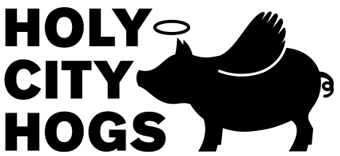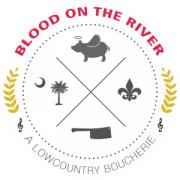Click here to add your own text
Early explorers brought livestock to the Americas beginning in the 1500s, including pigs that escaped or were deliberately set free in the New World. These pigs were the foundation for the historic populations of pigs in the southern United States. One of these is the Ossabaw, a free-range breed that is found on Ossabaw Island, off the coast of Georgia near Savannah. There is historic agreement that Ossabaw Island hogs have descended from foundation stock brought by Spanish explorers, inferring that the pigs are Spanish in origin. However, DNA analysis suggests that the Ossabaw Island pigs came from the Canary Islands, an important stop by the Spanish and Portuguese explorers en route to the New World. Mitochondrial DNA (mtDNA), which comes only from the maternal side, showed that the mtDNA of the Ossabaw Island pigs is more like that of the pigs on the Canary Islands, which reflects the influence of Asian pigs. The mtDNA of Spanish (or Iberian) pigs reflects only European influences. Additional genetic research is needed to understand the relationship of the pigs on the Canary Islands and on Ossabaw Island with Spanish pigs, including the paternal side of the DNA picture.
The Ossabaw pig breed is unusual and important for three reasons. Its history as an isolated island population has meant that the Ossabaw is the closest genetic representative of historic stocks brought over by the Spanish. Second, the presence of pigs on Ossabaw Island provides scientists with an exceptional opportunity to study a long-term natural population. Third, the Ossabaw breed is biologically unique, having been shaped by natural selection in a challenging environment known for heat, humidity, and seasonal scarcity of food. Ossabaw hogs may be as small as 100 pounds, but they are able to store astounding amounts of body fat in order to survive during the seasons when there is little to eat. This biochemical adaptation is similar to non-insulin dependent diabetes in humans, making the pigs a natural animal model for this disease. The pigs are also highly tolerant of dietary salt. Ossabaw Island hogs on the mainland, once removed from the selective pressures of their island home, have lost some of their unique survival adaptations. Their ability to fatten is both an advantage and a disadvantage, and breeders must watch their feed intake to prevent obesity.
Ossabaw hogs are usually black, although some are black with white spots or light with black spots. They have adaptations harking back to their history before being re-introduced to domestication. Adult pigs are very hairy with heavy bristles on the head, neck and topline. The frayed tips of the bristles, a primitive characteristic, are another indication of the distinctiveness of the population. Their snouts are long and slightly dished. Heads and shoulders of the hogs are heavy, and while they seem out of proportion to the rest of the body, that impression belies the speed and agility of these animals in the dense undergrowth of the island. True Ossabaws do not produce the striped piglets typical of populations that have had Wild Boar introductions.
Though pigs have lived on Ossabaw for several centuries, they do have an impact on the island’s ecology. Environmentalists became concerned, and the pigs may or may not be allowed to remain. The fate of the breed now rests upon complex questions of how it will be managed in its habitat without having a negative impact on the island’s ecology. Ossabaw Island pigs have been well established in domesticated herds on the mainland since the 1980s. They are found to be particularly well suited for sustainable or pastured pork production.
 The Mulefoot is an American hog breed that is named for its most distinctive feature, the solid, non-cloven hoof which looks like the hoof of a mule. This characteristic will occasionally occur as a single gene mutation, producing occasional “mulefooted” pigs within a variety of other breeds. In contrast, the Mulefoot breed is consistent in appearance and behavior, with qualities that have made it valuable in American history and a conservation priority today.
The Mulefoot is an American hog breed that is named for its most distinctive feature, the solid, non-cloven hoof which looks like the hoof of a mule. This characteristic will occasionally occur as a single gene mutation, producing occasional “mulefooted” pigs within a variety of other breeds. In contrast, the Mulefoot breed is consistent in appearance and behavior, with qualities that have made it valuable in American history and a conservation priority today.
The origin of the Mulefoot is unclear, and many theories have arisen about its links with mulefooted stocks in Asia and Europe. The breed is more likely to have descended from the Spanish hogs brought to the Americas beginning in the 1500s. It shares some attributes with the Choctaw hog, and the two breeds likely come from the same ancestral stock, which was loosely selected and managed until the late 1800s.
By 1900, the Mulefoot had become a standardized breed. It was valued for ease of -fattening and production of meat, lard, and especially hams. Mulefoot hogs were distributed throughout the Corn Belt. They were also common along the Mississippi River Valley, where farmers ranged their hogs on the islands in the river, putting them out to forage in the spring and collecting them in the fall. In the early 1900s there were two Mulefoot breed associations and over 200 herds registering purebred stock.
Mulefoot hogs are compact in appearance and weigh 400–600 pounds. They are solid black with white points occurring rarely. The ears are pricked forward. Some pigs have wattles on either side of the neck, though this is not common. The breed forages well and thrives under extensive husbandry. They have litters of 5-6 piglets but may have as many as 12. The sows make excellent and calm mothers.
The Mulefoot breed is critically rare. As of 2006 there were fewer than 200 purebred hogs documented. Most of these originated in the Holliday herd of Missouri, which is believed to be the last purebred herd in existence.
Credit: ALBC

